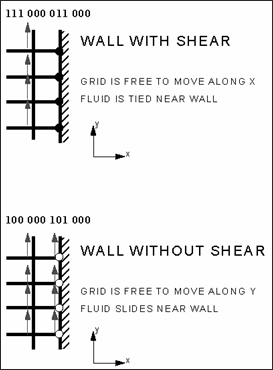Kinematic Constraints
- Conditions applied on the material velocities
- Conditions on grid velocity (ALE)
- Fixed and full slip boundary conditions
- Imposed velocities (for example: imposed flux at inlet)
- Rigid links (temporary adds during restarts)
- Rigid bodies to model rigid structures and connections and also to compute drag and lift forces (that is, fluid impulse on rigid body is stored in time history database).
Boundary Conditions

Figure 1. ALE Boundary Condition Applications
Rigid Body (/RBODY)
A rigid body is defined by a main node M and a set of secondary nodes. Rigid bodies are used in CFD application to compute reactive forces on structures.
ALE Links (VEL/ALE)
- Velocity is linearly interpolated with respect to input order
- Velocity is set to maximum absolute velocity of main nodes
- Velocity is set to minimum absolute velocity of main nodes